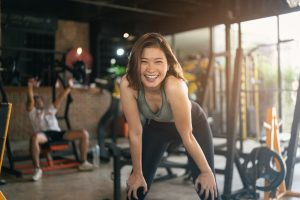How Acupuncture can assist with Sports Injury Treatment

Sports injury treatment is one of the areas of care that acupuncture is perhaps best known for, and for good reason. Acupuncture is widely used in sports and some of you may have read the praise given to acupuncture by elite athletes including Tour de France cyclists, Grand Slam tennis champions, Olympic swimming teams, and Champions League footballers, who have described the ways in which acupuncture helped them feel calm before a competition and supported a speedy recovery from injuries.
Acupuncture is also routinely used by those like me who are by no stretch of the imagination athletes, but who thoroughly enjoy their sport, fitness and exercise, and want to make sure that their bodies work at their best during exercise and generally recover well post-workout. Anyone who has suffered a sports injury or who suddenly notices a discomfort when exercising will know how frustrating, painful and disruptive to a training schedule this can be. As a completely natural therapy that has been tried and tested, acupuncture really is a great choice for anyone looking for an effective, easy and safe approach to sports injury treatment. So, what gives acupuncture the upper hand when it comes to sports injury treatment?
Causes of Sports Injury in Oriental Medicine
There are commonly three possible scenarios leading to injuries in sports: inadequate technique and/or poorly fitting training equipment; overuse of specific areas of the body and overexertion leading to excessive wear and tear with insufficient downtime to allow repair; or an accident, for instance a fall or other violent impact when performing sport. Once the sports injury has occurred, the body’s first response, which we become aware of, is pain as messages are sent to the brain by the nerves in the affected area and this will be followed by Inflammation.
These responses to injury are part of our in-built healing mechanisms, and while it is normal for the body to take some time to recover from any injury, acute and chronic injuries that persist would in Oriental Medicine be seen as indicative of an underlying depletion or weakness in a person’s system which the acupuncturist will seek to pinpoint using various diagnostic techniques. For it is this weakness that provides vital information on why the injury occurred in the first place, the level of pain it is causing and also why the person’s body is struggling to heal appropriately, and therefore on how best to approach treatment. In other words, the severity of the injury and associated pain, as well as the speed of recovery are important considerations in a diagnosis and treatment plan in Oriental Medicine. This is why an acupuncturist will always make sure that a detailed picture of a person’s overall physical health, their lifestyle, medical history, but also their mental wellbeing, mood, emotional tendencies, and so on, are all taken into account, as each of these aspects will strongly influence good function across body systems. Significantly, the depletion could be as much physical as mental, and while it may have come on the back of significant events in a person’s life, such as grief, divorce, redundancy, or illness, it is more commonly low level stresses on the body over a number of years that leave us running on empty. Work, relationships or family pressure, rushed meals where little thought is given to the nutritional content and taste of the food eaten, poor sleep routines, and even emotional volatility can be more depleting than we realise.
By looking at a sports injury in this way, acupuncture can integrate conventional medicine’s diagnostic information, which would normally take into account the site of the injury and associated pain, how the injury occurred, what it feels like, whether the pain travels in the body or is felt anywhere else, whether there are other associated symptoms, how long it has been going on for, what seems to make the pain worse or better, and how severe the pain is. These facts can then be interpreted according to the principles of Oriental Medicine, to ascertain which channels and organs are showing signs of distress. Further physical markers of health used in acupuncture, including the speed and quality of a person’s pulses can reveal any deficiencies in the vital substances of Qi (pronounced Chi) and Blood which are essential to support, nourish, repair and maintain all body functions.
Gathering this information and contextualising it in this way allows an acupuncturist to put together a treatment plan that is highly targeted, yet which takes a holistic view of the injury. In the Five Element style of acupuncture, additional diagnostic details can be used to fine tune the treatments, as certain organs are said to dominate in each individual, and also at particular times of day and year. Results can be enhanced therefore by working with a patient’s inner strengths and even body clock. It is in fact interesting to see how often the site or timing of injury correlates with traditional acupuncture diagnostic information, and how our susceptibility to injury is more predictable than we believe.
Path to Recovery
Traditional acupuncture’s approach to diagnosis is thorough and enables a very precise approach to sports injury treatment. While the specific selection of points targets the underlying problem, the effect of the needling itself triggers localised effects that reduce pain and encourage repair. More specifically, the sensation created at the site where the acupuncture is performed has been found to trigger parts of the brain that control sensitivity to pain, while also stimulating the nervous system so that the body releases its own natural pain killers, including endorphins and serotonin. The extremely fine needles used during an acupuncture treatment are often barely felt by the patient, yet are able to significantly increase blood flow, thereby helping diffuse the swelling and associated stiffness which makes post-injury movement more difficult. The needling additionally creates micro-trauma that kickstart natural healing mechanisms, not least by boosting the production of collagen to speed up recovery. It is worth remembering that acupuncture induces also a deep sense of relaxation, which is known to improve the speed at which we heal.
While the effect of acupuncture alone is often sufficient to help the body heal from the injury and to allow the patient to swiftly return to exercising, there are other adjunct techniques used in Oriental Medicine to treat sports injuries and resume normal activity. My favourite is a pressing and stroking massage technique called Gua-Sha used to release congestion in affected areas. Gua-Sha has been found in several studies to boost a person’s immune system and will therefore provide additional support to the body to help heal the injury. The technique is extremely easy to learn and can be taught to patients for self-care. It is important to bear in mind that recovery will also be hastened by making sure our lifestyles are supportive of good healing, and this will mean managing our stress levels, good nutrition, sleep and deep breathing.
Up Your Game with Acupuncture!
Whether your injury is old or new, and whatever level of sport you take part in, acupuncture can definitely help you get the most of your exercise and help you once again enjoy the sports you love. Acupuncture brings with it multiple health and wellbeing benefits, which can also reduce the likelihood of getting injured next time. Integrating acupuncture into your sports schedule and having it at the ready for any sports injury treatment, is not only a great way to get those niggling aches and pains sorted quickly, it is a must for anyone who takes their fitness routine seriously or wants to be at the top of their game.









